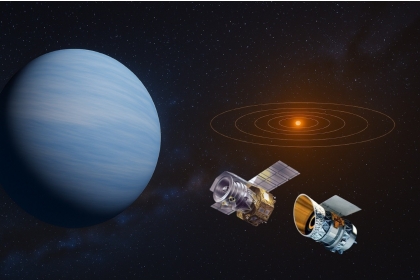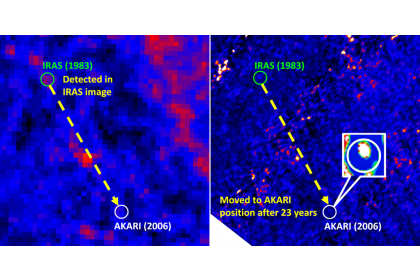A SEARCH FOR PLANET NINE WITH IRAS AND AKARI DATA
2025-05-26
興新聞張貼者
Unit秘書室
1,448
Authors: Terry Long Phan, Tomotsugu Goto, Issei Yamamura, Takao Nakagawa, Amos Y.-A. Chen, Cossas K.-W. Wu, Tetsuya Hashimoto, Simon C.-C. Ho, Seong Jin Kim
Published in Publications of the Astronomical Society of Australia (PASA). https://arxiv.org/abs/2504.17288
The outer solar system is theoretically predicted to host an undiscovered planet, commonly referred to as Planet Nine (Fig. 1). Numerical simulations suggest that its gravitational influence could account for the unusual clustering of trans-Neptunian objects in the Kuiper Belt. However, no direct observational evidence for Planet Nine has been found to date, as its proposed orbit lies far beyond Neptune, where it reflects only a very faint amount of sunlight.
This study aims to identify potential Planet Nine candidates by utilizing data from two far-infrared all-sky surveys: IRAS and AKARI. Given that Planet Nine is expected to move very slowly across the sky, we exploit the 23-year time baseline between the two surveys to search for objects that shift by only about 3 arcminutes per year. Our goal is to detect point sources that appear at one location in the IRAS images and at a different location in the AKARI images—an indication of proper motion.
To facilitate this search, we use a specialized far-infrared point source catalog from AKARI known as the AKARI-FIS Monthly Unconfirmed Source List (AKARI-MUSL). This catalog contains transient sources that were detected multiple times over several hours but were not confirmed months later, making it particularly suitable for identifying moving objects.
We generate all possible source pairs consisting of one IRAS and one AKARI detection, with angular separations between 42′ and 69.6′. These separations correspond to a heliocentric distance range of 500–700 AU and a planetary mass range of 7–17 Earth masses. After applying our selection criteria, we identify 13 candidate pairs. Among these, one promising candidate stands out: the IRAS source is not present at the same position in the AKARI image after 23 years, and vice versa, suggesting genuine motion (Fig. 2).
However, detections from IRAS and AKARI alone are insufficient to constrain the full orbital parameters of this candidate. Therefore, follow-up observations are required to determine its Keplerian motion and confirm whether it could indeed be Planet Nine.
Related News Links
Science news
https://www.science.org/content/article/astronomers-searching-planet-nine-find-possible-hints-different-planet
ABC news
https://www.facebook.com/share/15jZfBgACR
Yahoo Japan
https://news.yahoo.co.jp/expert/articles/fcb898c1f177b5c718442c739a9a701b860b762a
Published in Publications of the Astronomical Society of Australia (PASA). https://arxiv.org/abs/2504.17288
The outer solar system is theoretically predicted to host an undiscovered planet, commonly referred to as Planet Nine (Fig. 1). Numerical simulations suggest that its gravitational influence could account for the unusual clustering of trans-Neptunian objects in the Kuiper Belt. However, no direct observational evidence for Planet Nine has been found to date, as its proposed orbit lies far beyond Neptune, where it reflects only a very faint amount of sunlight.
This study aims to identify potential Planet Nine candidates by utilizing data from two far-infrared all-sky surveys: IRAS and AKARI. Given that Planet Nine is expected to move very slowly across the sky, we exploit the 23-year time baseline between the two surveys to search for objects that shift by only about 3 arcminutes per year. Our goal is to detect point sources that appear at one location in the IRAS images and at a different location in the AKARI images—an indication of proper motion.
To facilitate this search, we use a specialized far-infrared point source catalog from AKARI known as the AKARI-FIS Monthly Unconfirmed Source List (AKARI-MUSL). This catalog contains transient sources that were detected multiple times over several hours but were not confirmed months later, making it particularly suitable for identifying moving objects.
We generate all possible source pairs consisting of one IRAS and one AKARI detection, with angular separations between 42′ and 69.6′. These separations correspond to a heliocentric distance range of 500–700 AU and a planetary mass range of 7–17 Earth masses. After applying our selection criteria, we identify 13 candidate pairs. Among these, one promising candidate stands out: the IRAS source is not present at the same position in the AKARI image after 23 years, and vice versa, suggesting genuine motion (Fig. 2).
However, detections from IRAS and AKARI alone are insufficient to constrain the full orbital parameters of this candidate. Therefore, follow-up observations are required to determine its Keplerian motion and confirm whether it could indeed be Planet Nine.
Related News Links
Science news
https://www.science.org/content/article/astronomers-searching-planet-nine-find-possible-hints-different-planet
ABC news
https://www.facebook.com/share/15jZfBgACR
Yahoo Japan
https://news.yahoo.co.jp/expert/articles/fcb898c1f177b5c718442c739a9a701b860b762a




